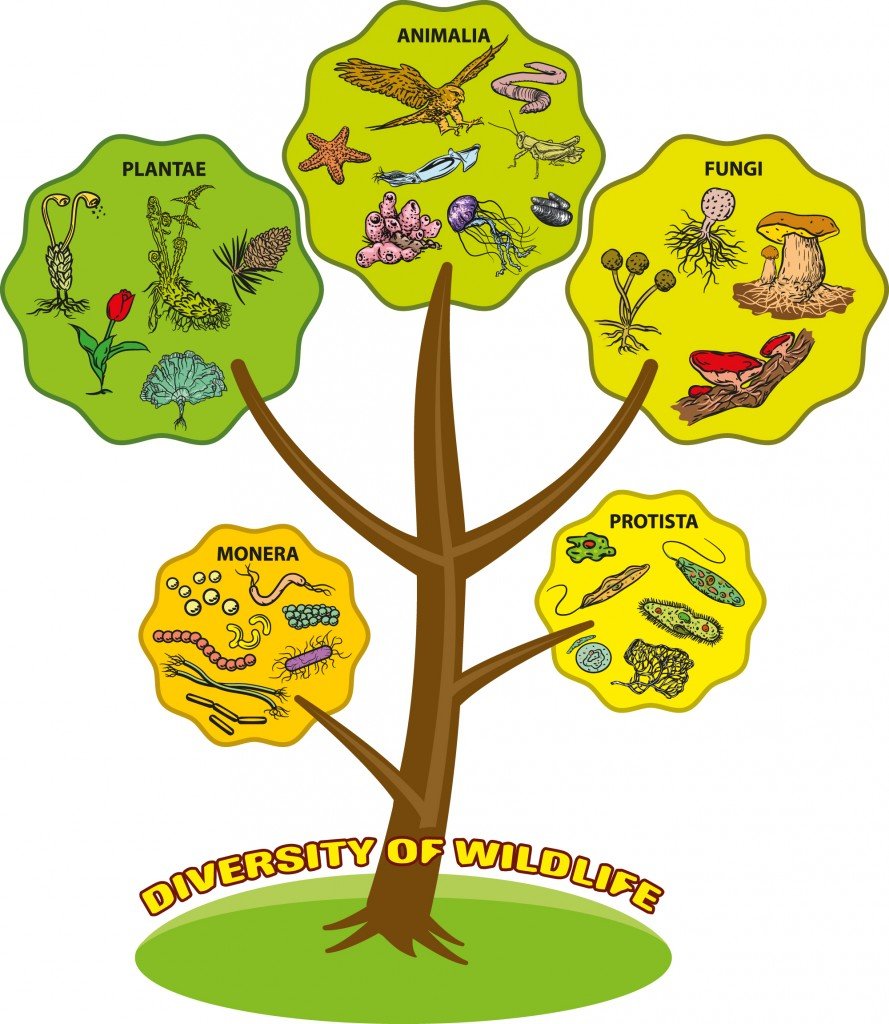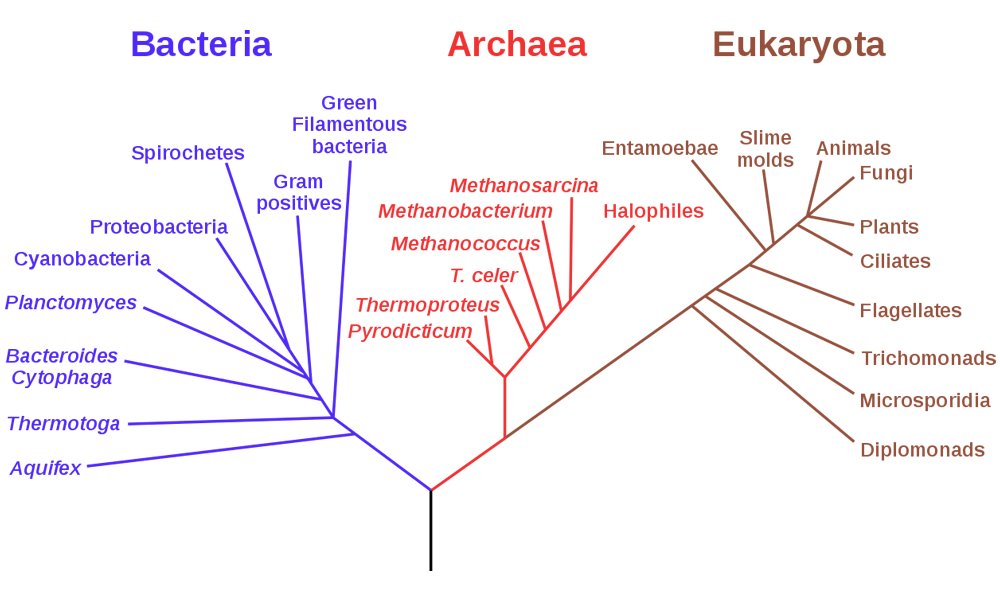Table of Contents (click to expand)
As it turns out, animals and fungi share a common ancestor, and branched away from plants at some point about 1.1 billion years ago. It was only later that animals and fungi separated, taxonomically speaking.
Think back to the last time you walked through a dense, overgrown forest. You probably saw all kinds of plant life – vines, bushes, moss, trees, and a healthy number of fallen logs. A forest is one of the best places to see the circle of life at its most beautiful, which is when life balances with death.
When things die in nature, they begin to break down and decompose, which is where fungi come into play.
Fungi belong to a kingdom all their own, just like animals, plants, bacteria, and protista (algae). They are eukaryotic organisms that absorb nutrients from other organic matter. When a tree falls, or an animal dies, fungi are typically the first on the scene to begin the natural process of decomposition.
Upon seeing a mushroom, most people would immediately view it as a vegetative organism, one that is closely related to plants. However, as recent research has shown, mushrooms are, in fact, more closely related to humans than to plants!
The Classification Of Living Organisms
Humans have always been fascinated by life in all its forms. Thousands of years ago, we classified life on earth into just two categories: plants and animals. Aristotle then further divided animals into those with and without blood and those in the land, sea, and air.
That rudimentary system remained in place until the 1600s. In the 18th century, Carl Linnaeus divided life into the kingdoms of animals and plants and then divided them further into different genera and species, which is why we have a two-part naming system in science (Homo sapiens, for example; Homo is the genus and sapiens is the species).
It wasn’t until the middle of the 19th century that single-celled organisms were finally given their due as a separate kingdom of life (Protista). Seventy years later, single-celled organisms were divided into eukaryotes and prokaryotes, so bacteria became the fourth kingdom of life. Although fungi had been recognized as a unique part of the animal kingdom, it was not until 1969 that it was divided into a separate kingdom. This five-kingdom system remains the most widely accepted format for classifying life on earth.

Until recently, all classifications of life, including the expansion from two kingdoms to five kingdoms, were based on physical observations of how things looked, even under a microscope. This is how the closeness and relationships between species, genera, classes, orders, and kingdoms were decided. Given this, it comes as no surprise that most people classified fungi as plants for so long. The similarity in appearance is pretty clear; after all, some look like little red and white trees.
Also Read: What Is Archaea?
Using Similarities In DNA To Classify Organisms
However, thanks to modern technology, the analysis of genetic relationships between species and organisms is now possible and has led to looking at relationships between forms of life differently. In 1990, Carl Woese proposed the “Three Domains System” of classification based on genetic similarities between organisms. The system shows a common ancestor of all life divided into three broad domains—Bacteria, Archaea, and Eukaryotes (the organisms with a nucleus to store their DNA).
By examining the genes of different species, both animal and fungi, mutational changes can be observed, and genealogical relationships can be determined that stretch back millions of years.
As it turns out, animals and fungi share a common ancestor and branched away from plants sometime around 1.1 billion years ago. Only later did animals and fungi separate on the genealogical tree of life, making fungi more closely related to humans than plants. Most likely, this common ancestor was a single-celled organism that exhibited sperm-like characteristics (like an animal) and then a later developmental stage with a stronger cell wall (fungi).

Are Mushrooms Vegetables?
Simple answer? No, a mushroom is not a vegetable. Mushrooms are fruiting bodies of macroscopic filamentous fungi. When mycology (the study of fungi) first arose, it was a part of botany because fungi were regarded as primitive plants.
The main difference between a plant (vegetable) and a mushroom is how they acquire their food. Plants possess chlorophyll and produce their food through photosynthesis. Fungi exist on decaying material in nature. In addition, there are obvious structural differences, such as the lack of leaves, roots, and seeds. Thus, fungi now have their own kingdom based on the cellular organization.
However, this is the scientific side of things, but let’s take a look at the other side – food! In everyday life, we do not use science to classify our food. Tomatoes and cucumbers are scientifically the fruits of a plant, but we still call them vegetables. Similarly, mushrooms are not vegetables or fruits, or even meat. They are in themselves a different category, but for convenience, we lump them together with vegetables.
Different kinds of mushrooms have various health benefits. At one point in history, mushrooms were so highly regarded that it was actually forbidden for the common folk to eat them! They were reserved only for royal families.
Also Read: What’s The Difference Between Plant And Animal Cells?
The Mushrooms And Men Have Similar DNA.
Haven’t you ever noticed that eating a perfectly cooked portobello mushroom feels a lot closer to eating meat than a salad? Well, that isn’t exactly a scientific explanation of the connection, but genetic studies show that there may be a common ancestor from which both animals and fungi evolved.
In 1993, researchers Baldouf and Palmer published a paper, ‘Animals and fungi are each other’s closest relatives: congruent evidence from multiple proteins’. They compared 25 proteins and their DNA sequences between bacteria, plants, animals, and fungi. They found that animals and fungi exhibited similarities in certain proteins that plants and bacteria did not have. “This congruence among multiple lines of evidence strongly suggests, in contrast to the traditional and current classification, that animals and fungi are sister groups, while plants constitute an independent evolutionary lineage,” the researchers write in their paper.
A 2005 paper described how both animals and fungi are relatives of protists through protein analysis. Researchers are still teasing out the complex relationships between animals and fungi, but there is enough evidence to suggest that you and a mushroom have more in common than a plant has with a mushroom.
Also Read: What’s The Difference Between Mushrooms And Toadstools?
How much do you remember about your mushoom relations?
Can you answer three questions based on the article you just read?

References (click to expand)
- Steenkamp, E. T., Wright, J., & Baldauf, S. L. (2005, September 8). The Protistan Origins of Animals and Fungi. Molecular Biology and Evolution. Oxford University Press (OUP).
- Baldauf, S. L., & Palmer, J. D. (1993, December 15). Animals and fungi are each other's closest relatives: congruent evidence from multiple proteins. Proceedings of the National Academy of Sciences. Proceedings of the National Academy of Sciences.
- Rearranging the Branches on a New Tree of Life. The University of California, Berkeley
